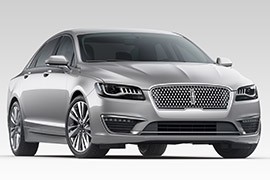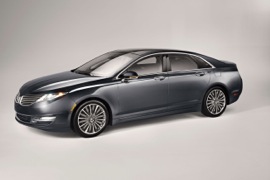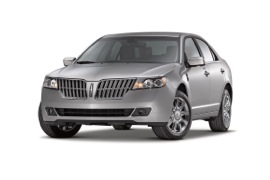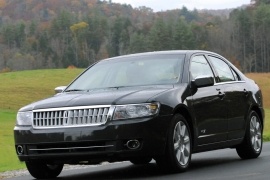LINCOLN MKZ Models/Series Timeline, Specifications & Photos
First production year: 2006
Engines: Gasoline, Hybrid
Lincoln refreshed the second generation of the MKZ for the 2017 model year, and the automaker completely changed the former minimalist interior that made it stand out from the crowd.
The luxurious sedan was unveiled in late 2016 at the Los Angeles Auto Show, and compared to its non-facelifted version, it looked like a completely different vehicle. Nevertheless, Ford tried to impress and get a bigger slice of the mid-size sedan premium market, and not only that it offered the vehicle an upgraded aesthetic, but it also made some changes on the technical side.
Lincoln ditched the former wing-style look of the front fascia and installed a mesh grille that sported the automaker's badge in the middle. It was flanked by redesigned headlights with a less swept-back look than on the 2013 model. In addition, the carmaker offered an option for LEDs, drastically improving nighttime illumination.
Inside, the automaker listened to what customers said about the 2013 model and replaced the formerly used sliding touch sensors for most commands with regular dials. Truth be told, those touch screens only look good in pictures, but they are a nightmare to use in daily driving situations. Still, it kept the buttons for the gear selector on the driver's side of the center stack. One of its main advantages over its competitors was the sliding panoramic roof.
Under the hood, Lincoln installed a completely new turbocharged V6 that replaced the previously used 3.7-liter naturally aspirated unit. Also, for base versions, a 2.0-liter inline-four was available. Both front or all-wheel drive options were on the list.
Ford was committed to making Lincoln relevant again in the premium segment when it launched the MKZ in 2013.
Even if it is based on the Ford Fusion platform CD4, which was also used on the European Mondeo, the Lincoln MKZ gave all that it takes to impress on all of its bits and pieces. For starters, there was a new interpretation of Lincoln's double-wing grille, which includes the headlights. The aggressive line didn't trade the image of a luxury sedan for a sporty vehicle. But it was odd to see the modern interpretation of the front end and the line for the taillights, that looked outdated even if it was with LED.
Inside, the luxury was the keyword. Leather bolstered seats with tons of adjustments available, high-quality materials used and a high-tech infotainment unit marked the move of Lincoln toward younger buyers. The Ford's SYNC 2 system was installed, but badged as "MyLincoln Touch". It could connect to a smartphone via a dedicated app, but it wasn't compatible with the Android Auto or Apple CarPlay. The big interior was achieved thanks to a big wheelbase, which allowed room for three adults. The MKZ had an optional big, openable, panoramic glass roof.
Under the hood, there was a 3.7-liter V6 unavailable on the Ford Fusion, but the 2.0-liter EcoBoost and the hybrid version were the same. The MKZ was available with either 2WD or all-wheel-drive. The only transmission available was a 6-speed automatic.
An upscale version of the Ford Fusion, the Lincoln MKZ was a refined and stylish 4-door sedan.
In 2010, the MKZ was refreshed and the updates included a redesigned front end with a wing-split grille, as well as a revised rear styling with larger LED taillights. The interior was also updated.
Compared to the Cadillac CTS, the Lincoln MKZ was more focused on offering a supple ride quality, rather then being as sporty as the CTS was.
Under the hood, the Lincoln MKZ was equipped with a 3.5-liter V6 engine that produced 263 hp. While not especially fast, the unit offered more than sufficient power.
Buyers could choose between a front- or an all-wheel-drive system, with the all-wheel-drive system providing a reduced fuel consumption.
The fully independent suspension was completely revised, and with the Sport Appearance package, it was even stiffer, besides the larger wheels it came with.
The interior of the MKZ was greatly finished with high quality materials and fitted with comfortable seats where legroom and headroom was never an issue.
In its base version, the Lincoln MKZ came with standard leather upholstery, dual-zone climate control, parking sensors, heated and cooled front seats, as well as Lincoln’s SYNC infotainment system. Optionally, a power sunroof, a dvd-based navigation and a back-up camera were available for an extra fee.
The Sport package also added unique seat upholstery and different trim materials.
Introduced in 2006 at the Chicago Auto Show, the Lincoln Zephyr was a medium-sized vehicle based on the same platform as Mazda6/Atenza or the Ford Edge. It had only a 3.0-liter V6 engine available from the beginning, offering 221 hp and 278 Nm (205 lb-ft) of torque. A year later, a 3.5-liter V6 joined the engine range. It was fitted as standard with a 6-speed Aisin automatic gearbox. Also in 2007, the Zephyr name was changed to MKZ until 2012. In 2011 it received a hybrid powertrain with an inline four-cylinder with a 2.5-liter displacement gasoline engine and an electric motor. The total output for the hybrid version was 191 hp.
The interior was typical for a Lincoln, with real ebony and maple wood installed in metallic frames. Leather seats were standard on all the trim levels. Electrically adjustable seats, a six-speaker audio system and dual climate control along with a big list of features were installed as standard.
Inside the 4.8 meter (15.7 ft) long vehicle, the rear seat legroom was decent due to the 2.7 m (8.8 ft) wheelbase. The Zephyr/MKZ was intended to replace the former mid-size Lincoln LS range, but with more fuel-efficient engines and front-wheel-drive. A facelift was introduced in 2010 and a new generation was launched in 2013.



